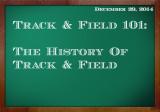Folders |
Track and Field 101 - The History Of Track and FieldPublished by
Ka’Deem Wynn | Writer
It’s that time of year again. Most if not all of the major cross country races are over. With track season fast approaching, I felt that it was the perfect time to give another history lesson.
Much like my love and interest in cross country and running altogether, I’ve grown increasingly curious about the true and intricate details surrounding the history of the sport that I love.
This time, we’re going further than the early 19th century. Square One: Greece
Most people know that track as a sport was started and made widely popular by the Greeks. We know that they had events like javelin throwing and other physical activities to show their strength. However, that’s all we really know, and to be frank, care to know.
The amount of events at the Games expanded in later years. Though it now included further running competitions, the introduction of the Ancient Olympic pentathlon marked a step towards track and field as it is recognized today. It now comprised a five-event
competition of the long jump, javelin throw, discus throw, stadion footrace, and wrestling. Track and field events were also present at the Panhellenic Games in Greece around this period, and around 200 BC, they spread to Rome.
Development Of Modern Track After the period of Classical antiquity (in which the sport was largely Greco-Roman influenced) new track and field events began developing in parts of Northern Europe in the Middle Ages. The stone put and weight throw competitions popular among Celtic societies in Ireland and Scotland were precursors to the modern shot put and hammer throw events.
One of the last track and field events to develop was the pole vault, which stemmed from competitions such as the Fierljeppen contests (which is where you run, jump over a body of water while sticking a pole in the ground, and attempt to climb to the top while controlling the movements of the pole) in the Northern European Lowlands in the 18th century.
Discrete modern track and field competitions, separate from general sporting festivals, were first recorded in the 19th century. These were typically organized by educational institutions, military organizations and sports clubs as competitions between rival establishments The Royal Shrewsbury School Hunt is the oldest running club in the world, with written records going back to 1831 and evidence that it was established by 1819. This brought us what would turn into modern day cross country, or as it was called Paper Chase & Hare and Hounds.
Shrewsbury's Annual Steeplechase (which made steeplechase another event added to track & field) first definite record was in 1834, making it the oldest running race of the modern era. Steeplechase, at that time, was just off-season training for cross country. Shrewsbury also lays claim to the oldest track and field meeting still in existence, originating in the Second Spring Meeting first documented in 1840. This featured a series of throwing and jumping events with mock horse races including the Derby Stakes, the Hurdle Race and the Trial Stakes. Runners were entered by "owners" and named as though they were horses. A decade later, the first Wenlock Olympian Games were held at Much Wenlock racecourse. Events at the 1851 Wenlock Games included a "half-mile foot race" (805 m) and a "leaping in distance" competition.
USATF, Olympics, and IAAF
Union des sociétés françaises de sports athlétiques in 1889) put the sport on a formal footing and that made international competitions possible.
The establishment of the modern Olympic Games at the end of the 19th century marked a new high for track and field. The Olympic athletics program, comprising track and field events plus a marathon race, contained many of the foremost sporting competitions of the 1896 Summer Olympics. The Olympics also consolidated the use of metric measurements in international track and field events, both for race distances and for measuring jumps and throws.
The Olympic athletics program greatly expanded over the next decades, and track and field contests remained among the Games' most prominent. The Olympics was the elite competition for track and field, and only amateur sportsmen could compete.
That same year, the International Amateur Athletic Federation━now International Association of Athletics Federations━(IAAF) was established, becoming the international governing body for track and field, and it enshrined amateurism as one of its founding principles for the sport. The National Collegiate Athletic Association (NCAA) held their first Men's Outdoor Track and Field Championship in 1921, making it one of the most prestigious competitions for students, and this was soon followed by the introduction of track and field at the inaugural World Student Games in 1923. The first continental track and field competition was the 1919 South American Championships, which was followed by the European Athletics Championships in 1934.
Until the early 1920s, track and field had been almost exclusively male-only. Growing women's sports movement in Europe and North America led to the establishment of the Women's World Games in 1921 and this ultimately caused the introduction of five track and field events for women in the athletics at the 1928 Summer Olympics. In China, women's track and field events were being held in the 1920s, but were subject to criticism and disrespect from audiences.
The rise of Kinue Hitomi and her 1928 Olympic medal for Japan signified the growth of women's track and field in East Asia. More women's events were introduced as years progressed, although it was only towards the end of the century that the men's and women's programs approached parity of events.
Marking an increasingly inclusive approach to the sport, major track and field competitions for disabled athletes were first introduced at the 1960 Summer Paralympics. Running Boom Since the days of Steve Prefontaine, track & field as a whole has gained immense popularity. Though it started much back in the days of Jesse Owens, Jim Ryun, Roger Bannister, and “Bullet” Bob Hayes, stars like Carl Lewis, Ben Johnson, and Michael Johnson, helped boost the enthusiasm for the sport during the 1980s and 1990s. As time progressed and old stars faded, new stars would emerge. Because of runners like Usain Bolt, or Justin Gatlin, the 100 meter dash is one of the marquee events in track & field, and everyone who runs it wants to be the next sprinting legend on the track (or if you’re like me, the next David Rudisha).
Track Then And Now
see competition, and they always will. There’s always the need to see who is the fastest in what, and how fast can it be done. Now, if you’re ever having a conversation about track & field with a friend, you can bring in interesting tidbits about the history of track & field. Why?
Because now you know. More news |















 Track & field-styled events are among the oldest forms of sporting competition, as running, jumping, and throwing were a usual part of human physical expression. The first recorded examples of organized track and field events at a sports festival are the Ancient Olympic Games. At the first Games in 776 BC in Olympia, Greece, only one event was contested: the stadion footrace, which was a 200-yard sprint (about 180 meters).
Track & field-styled events are among the oldest forms of sporting competition, as running, jumping, and throwing were a usual part of human physical expression. The first recorded examples of organized track and field events at a sports festival are the Ancient Olympic Games. At the first Games in 776 BC in Olympia, Greece, only one event was contested: the stadion footrace, which was a 200-yard sprint (about 180 meters). 
 The United States began holding an annual national competition—the USA Outdoor Track and Field Championships—in 1876. It was first held by the New York Athletic Club. Two years later, on January 30, 1878, USA Track & Field was officially founded. With USATF now in place, other organizations came about. The establishment of general sports governing bodies for the United States (the Amateur Athletic
The United States began holding an annual national competition—the USA Outdoor Track and Field Championships—in 1876. It was first held by the New York Athletic Club. Two years later, on January 30, 1878, USA Track & Field was officially founded. With USATF now in place, other organizations came about. The establishment of general sports governing bodies for the United States (the Amateur Athletic 
 Over the years, track & field as an overall sport has evolved in many different ways. However, despite all of the changes, much of it is still that same━of course now we have state of the art facilities, training methods, etc. But the bottom line is that, just like in the days of Ancient Greece, track & field is one of the most highlighted and celebrated sporting events in the world. People have always loved to
Over the years, track & field as an overall sport has evolved in many different ways. However, despite all of the changes, much of it is still that same━of course now we have state of the art facilities, training methods, etc. But the bottom line is that, just like in the days of Ancient Greece, track & field is one of the most highlighted and celebrated sporting events in the world. People have always loved to